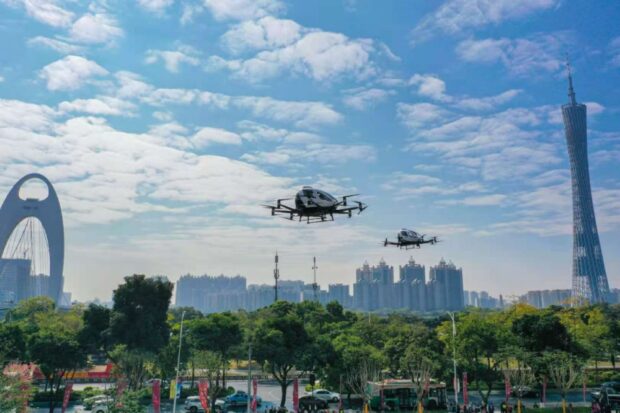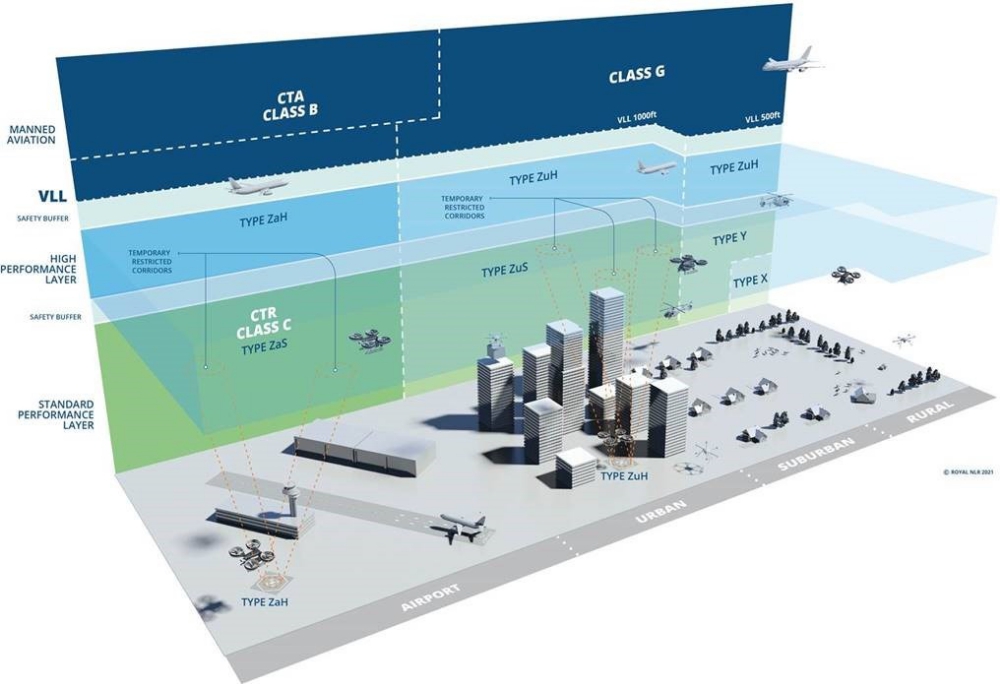A new European project, AMU-LED, is now carrying out coordination and substantial testing to manage this airspace traffic and check safety, interoperability and feasibility. The first trial demonstration took place at Cranfield University, UK, on 30 June, and will be followed by other trial events in the Netherlands and Spain.
In the near future city-dwellers can expect to see a variety of drones in the airspace above where they live, perhaps transporting patients to hospitals, helping tackle fires, or simply delivering parcels. This vision of Urban Air Mobility (UAM), making use of different types of drones, will also help people travel faster and more efficiently through unmanned air taxis – and researchers say it will be in place in a matter of a few years.
Testing scenarios in urban environments
One of the key enablers for UAM is U-space, an air traffic management framework to enable the safe and secure integration of drones. U-space is a set of specific services and procedures designed to ensure safe and efficient access to airspace for a large number of drones, based on high levels of digitalization and automation.
Just like the air traffic management system for general aircraft, U-space will ensure that drone operations are carried out safely and efficiently. The system is more automated than current air traffic control, with less human interaction and the capacity to handle more flights simultaneously.
The development of U-space and UAM has been accelerating through research and innovation projects and technological developments.
The AMU-LED project is a Very Large-scale Demonstration (VLD) project funded by the SESAR Joint Undertaking under the European Union’s Horizon 2020 research and innovation programme. AMU-LED will demonstrate the safe integration of manned and unmanned aircraft through U-space, with the ultimate goal of realising increasingly sustainable smart cities. A key step towards this is performing flight demonstrations with various scenarios, situations and use cases in urban environments.
In a series of demos, the project will use large electrical Vertical Take-off and Landing (eVTOL) platforms for passenger and cargo transport, combined with smaller Unmanned Aerial Systems (UAS) performing delivery of goods and medical supplies, surveillance or support for emergency services.
Testing data exchange
The range of locations allows the project to test a variety of aspects, such as assessing the most efficient way to exchange information between actors (such as the drones, their pilots and the air traffic management system). The project will also test two different concepts for Unmanned Traffic Management architectures.
The information to be exchanged includes data such as strategic and tactical information prior and during the flight, tracking data (real time information about the position of the drone), advisory tactical deconfliction service (information to avoid any conflicts prior to the flight and during the flight), and the provision of weather and Communication, Navigation and Surveillance (CNS) data.
Demonstrations pave the way for highways in the skies
Gokhan Inalhan, Professor of Autonomous Systems and Artificial Intelligence, is leading Cranfield University’s involvement in the project. He said: “The flight demonstrations will put into practice scenarios, concepts and systems developed throughout the project to test how drones and manned aircraft can operate safely in the same airspace.
“At Cranfield, we will be running virtual flights alongside the drones physically flying at the airport, to test their interactions and air traffic management systems including U-Space. Our results will help inform the later demonstrations and move forward the whole concept of Urban Air Mobility.
“This is a very exciting project and one that will pave the way for highways in the skies, removing traffic and congestion and changing the way we move around.”
Project ready for take-off in series of demonstrations
“After having carried out an impressive amount of work, where our consortium devised and implemented cutting edge concepts of operations for UAM, prepared futuristic yet round-the-corner use cases such as air commute shuttle or last-mile parcel delivery, and integrated innovative unmanned traffic management services, at last we are ready for take-off”, clarifies Pablo Menéndez-Ponte Alonso, project leader UTM of NTT DATA Spain that coordinates the European consortium of 17 different entities that take part in the AMU-LED project. “Cranfield is our first essential demonstration, as it will allow us to understand the readiness of this technology by confronting the actual challenge.”
There will be six demonstrations in total, taking place throughout summer of 2022, in Cranfield (UK), Amsterdam (NL), Enschede (NL), Rotterdam (NL), and Santiago de Compostela (SP). Throughout these demonstrations the project team will gather data on the different aspects being tested, which will afterwards be analysed. This will enable the project to draw results for the further development of U-space, providing information on the most efficient way for U-space to enable UAM, providing a safe, impactful and viable solution for smart cities.
More information about each demonstration:
As U-space and UAM are still concepts in development, AMU-LED is following the three pillars of innovation – feasibility, viability, and desirability – to ensure that the demonstrations cover all requirements for an effectual implementation of UAM.
The demonstrations start with the feasibility case in Cranfield, proving the readiness of the AMU-LED solution, technologies, and systems. These tests are led by Cranfield University, and will take place at Cranfield Airport, a unique facility which has its own Air Navigation Service Provider and air traffic controllers, and its own pilots and aircraft. This demonstration will be a prerequisite for the subsequent demonstrations, proving that the AMU-LED solution is ready and safe to be tested in more complex environments. A second part of the Cranfield demonstration will take place in September.
After proving the feasibility of the AMU-LED solution, the project will continue testing the desirability of its solution in Amsterdam and Enschede, with a focus on public acceptance and social impact respectively.
In Amsterdam, the tests are led by the Royal Netherlands Aerospace Centre (NLR), and will take place in the heart of city, at the Marineterrein. Using a focus group to gather data, the team will perform various flight demonstrations, testing different aspects of U-space and the certain public acceptance indicators such as noise nuisance, perceived safety, trust in the technology, privacy concerns or visual pollution. Mitigation measures for the concerns raised by the focus group will be proposed on the basis of the data gathered.
Enschede will follow, demonstrating the social impact of UAM. Space53, a test and innovation centre for unmanned systems, is in charge of this demonstration, which will take place between the Space53 location at Technology base and Twente Airport and the city of Enschede. Showcasing various socially relevant use cases such as medical delivery, firefighting, or police surveillance, this demonstration will prove the social impact that UAM will create when implemented.
In Rotterdam, the economic viability of UAM will be demonstrated also in August. This test is being coordinated by AirHub and will take place in the port area of the city. It will be done in collaboration with the Port of Rotterdam Authority, which wants to investigate the viability of transporting ships’ crews directly from the vessel to the hotel. Other use cases will be showcased as well, flying different UAVs and VTOL aircraft.
The city of Santiago de Compostela will host the final demonstration of AMU-LED, where all the previous aspects – feasibility, viability and desirability – come together in a big final show. Coordinated by the technology centre ITG – Fundación Instituto Tecnológico de Galicia the demonstration will focus on the correct implementation of all the aspects in urban environments, as the final showcase of how U-space can enable Urban Air Mobility. This will be demonstrated in September and in October.
Throughout these demonstrations, the project team will gather data about the various aspects being tested, which will then be analysed. This will let the project draw up results for the further development of U-space, providing information about the most efficient way for U-space to enable UAM, providing a safe, effective and viable solution for smart cities.
Source: Press Release


